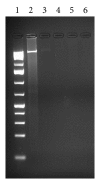The acetone extract of Sclerocarya birrea (Anacardiaceae) possesses antiproliferative and apoptotic potential against human breast cancer cell lines (MCF-7)
- PMID: 23576913
- PMCID: PMC3616355
- DOI: 10.1155/2013/956206
The acetone extract of Sclerocarya birrea (Anacardiaceae) possesses antiproliferative and apoptotic potential against human breast cancer cell lines (MCF-7)
Abstract
Interesting antimicrobial data from the stem bark of Sclerocarya birrea, which support its use in traditional medicine for the treatment of many diseases, have been delineated. The current study was aimed to further study some pharmacological and toxicological properties of the plant to scientifically justify its use. Anticancer activity of water and acetone extracts of S. birrea was evaluated on three different cell lines, HT-29, HeLa, and MCF-7 using the cell titre blue viability assay in 96-well plates. Apoptosis was evaluated using the acridine orange and propidium iodide staining method, while morphological structure of treated cells was examined using SEM. The acetone extract exhibited remarkable antiproliferative activities on MCF-7 cell lines at dose- and time-dependent manners (24 h and 48 h of incubation). The extract also exerted apoptotic programmed cell death in MCF-7 cells with significant effect on the DNA. Morphological examination also displayed apoptotic characteristics in the treated cells, including clumping, condensation, and culminating to budding of the cells to produce membrane-bound fragmentation, as well as formation of apoptotic bodies. The acetone extract of S. birrea possesses antiproliferative and apoptotic potential against MCF-7-treated cells and could be further exploited as a potential lead in anticancer therapy.
Figures





Similar articles
-
Evaluation of the analgesic, anti-inflammatory and anti-diabetic properties of Sclerocarya birrea (A. Rich.) Hochst. stem-bark aqueous extract in mice and rats.Phytother Res. 2004 Aug;18(8):601-8. doi: 10.1002/ptr.1503. Phytother Res. 2004. PMID: 15476310
-
Hypoglycemic effect of Sclerocarya birrea [(A. Rich.) Hochst.] [Anacardiaceae] stem-bark aqueous extract in rats.Phytomedicine. 2003 Nov;10(8):675-81. doi: 10.1078/0944-7113-00295. Phytomedicine. 2003. PMID: 14692729
-
Effect of Sclerocarya birrea (Anacardiaceae) stem bark methylene chloride/methanol extract on streptozotocin-diabetic rats.J Ethnopharmacol. 2007 Apr 4;110(3):434-8. doi: 10.1016/j.jep.2006.10.020. Epub 2006 Oct 26. J Ethnopharmacol. 2007. PMID: 17141993
-
Sclerocarya birrea (A. Rich) Hochst. ['Marula'] (Anacardiaceae): a review of its phytochemistry, pharmacology and toxicology and its ethnomedicinal uses.Phytother Res. 2010 May;24(5):633-9. doi: 10.1002/ptr.3080. Phytother Res. 2010. PMID: 20013815 Review.
-
Amphipterygium adstringens (Schltdl.) Schiede ex Standl (Anacardiaceae): An Endemic Plant with Relevant Pharmacological Properties.Plants (Basel). 2022 Jul 2;11(13):1766. doi: 10.3390/plants11131766. Plants (Basel). 2022. PMID: 35807718 Free PMC article. Review.
Cited by
-
Synthesis, characterization, and anticancer activity of new quinazoline derivatives against MCF-7 cells.ScientificWorldJournal. 2014;2014:212096. doi: 10.1155/2014/212096. Epub 2014 Dec 4. ScientificWorldJournal. 2014. PMID: 25548779 Free PMC article.
-
In-vitro Assessment of the Antiproliferative and Apoptotic Potential of the Ethyl acetate Extract of Peltophorumafricanum on Different Cancer Cell Lines.Iran J Pharm Res. 2017 Spring;16(2):714-724. Iran J Pharm Res. 2017. PMID: 28979326 Free PMC article.
-
Phytochemical screening and in vitro antibacterial and anticancer activities of the aqueous extract of Cucumis sativus.Saudi J Biol Sci. 2019 Mar;26(3):600-604. doi: 10.1016/j.sjbs.2018.07.012. Epub 2018 Jul 31. Saudi J Biol Sci. 2019. PMID: 30899178 Free PMC article.
-
Ethnobotanical knowledge of the lay people of Blouberg area (Pedi tribe), Limpopo Province, South Africa.J Ethnobiol Ethnomed. 2018 Jul 13;14(1):46. doi: 10.1186/s13002-018-0245-4. J Ethnobiol Ethnomed. 2018. PMID: 30001728 Free PMC article.
-
Antiproliferative Activity of T. welwitschii Extract on Jurkat T Cells In Vitro.Biomed Res Int. 2015;2015:817624. doi: 10.1155/2015/817624. Epub 2015 Oct 18. Biomed Res Int. 2015. PMID: 26557698 Free PMC article.
References
-
- Bieche I. Biologie moléculaire des cancers. Immuno-Analyse & Biologie. 2004;19:13–22.
-
- Mbaveng AT, Kuete V, Mapunya BM, et al. Evaluation of four Cameroonian medicinal plants for anticancer, antigonorrheal and antireverse transcriptase activities. Environmental Toxicology and Pharmacology. 2011;32(2):162–167. - PubMed
-
- Tan ML, Sulaiman SF, Najimuddin N, Samian MR, Muhammad TST. Methanolic extract of Pereskia bleo (Kunth) DC. (Cactaceae) induces apoptosis in breast carcinoma, T47-D cell line. Journal of Ethnopharmacology. 2005;96(1-2):287–294. - PubMed
-
- Hilakivi-Clarke L, Wang C, Kalil M, Riggins R, Pestell RG. Nutritional modulation of the cell cycle and breast cancer. Endocrine-Related Cancer. 2004;11(4):603–622. - PubMed
Publication types
MeSH terms
Substances
LinkOut - more resources
Full Text Sources
Other Literature Sources

